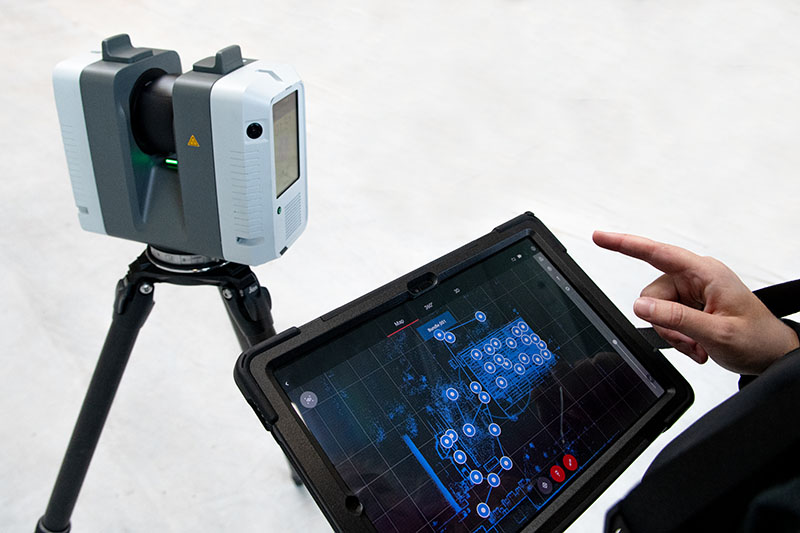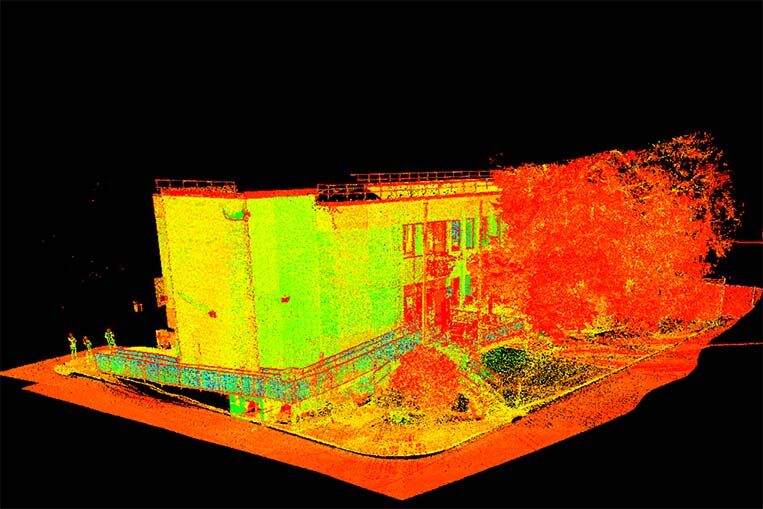How 3D Scanning Eliminates Project Errors
Wiki Article
Enhancing Production Processes: The Influence of 3D Laser Scanning on Top Quality Control
3D laser scanning modern technology is changing quality assurance in production. By providing precise measurements and high-resolution data, it makes it possible for manufacturers to identify deviations from requirements easily. This innovation not just simplifies examination procedures however likewise enhances operational efficiency. 3D Scanning. The application of this innovation comes with its very own collection of difficulties. Exploring these aspects discloses the wider implications for sectors and the future landscape of production
Understanding 3D Laser Scanning Technology
Although 3D laser scanning modern technology has evolved significantly over the last few years, its essential principle remains simple: recording the accurate geometry of items making use of laser beams. This innovation utilizes laser light to determine ranges in between the scanner and numerous factors on a things's surface area. The information accumulated is after that refined to develop a thorough 3D version, properly mirroring the measurements and contours of the scanned object.Normally, 3D laser scanners can be classified right into two main types: contact and non-contact scanners. Contact scanners literally touch the things to collect dimensions, whereas non-contact scanners make use of laser beam of lights to catch data from a distance. The versatility of this technology allows its application throughout different markets, including manufacturing, architecture, and building and construction. Its ability to generate high-resolution versions facilitates top quality control, reverse design, and fast prototyping, ultimately boosting style accuracy and performance in production processes.
Advantages of 3D Laser Scanning in Manufacturing
As manufacturers seek to boost effectiveness and precision in their processes, the advantages of 3D laser scanning have come to be progressively evident. This cutting-edge innovation allows for fast and highly exact measurements of intricate geometries, significantly reducing the moment required for high quality checks. By capturing in-depth data, makers can identify inconsistencies early in the production process, thus minimizing waste and remodel prices.Additionally, 3D laser scanning helps with far better design validation, making it possible for engineers to contrast as-built conditions with initial specifications. This ability assures that any type of variances are promptly addressed, improving general product quality. Furthermore, the innovation supports the creation of digital doubles, which can be made use of for simulations and procedure optimizations. Consequently, producers not just raise their functional efficiency but likewise improve their affordable benefit in the market. Overall, the integration of 3D laser scanning represents a transformative step toward achieving greater requirements in producing quality assurance.
Combination of 3D Laser Scanning Into High Quality Control
Incorporating 3D laser scanning right into top quality control procedures boosts the precision and performance of inspections throughout manufacturing. This technology enables manufacturers to capture detailed, high-resolution information of parts and settings up, permitting accurate measurements and comparisons against design specifications. By using 3D laser scanning, companies can determine variances from tolerances much more efficiently, which is vital for keeping item honesty.
Real-World Applications and Study
Real-world applications of 3D laser scanning in manufacturing demonstrate its transformative influence throughout numerous sectors. Aerospace companies utilize this technology to perform specific examinations of elements, ensuring they fulfill rigid safety criteria. A significant case included a leading aircraft maker that employed 3D laser scanning to enhance its quality control processes, substantially decreasing inspection times and errors.In the automotive market, manufacturers have actually implemented laser scanning to create electronic doubles of their automobiles, making it possible for real-time adjustments throughout production. One automobile firm reported a 30% reduction in rework prices after incorporating this modern technology right into their production line.
In the customer products industry, business are using 3D laser scanning for fast prototyping, permitting for quicker versions and boosted product layouts. These applications illustrate exactly how 3D laser scanning not just enhances accuracy however additionally enhances performance and development throughout multiple manufacturing domain names.
Conquering Obstacles in Implementation
Carrying out 3D laser scanning in making presents several challenges that organizations must browse to fully recognize Check Out Your URL its advantages. One substantial difficulty is the initial expense of devices and software application, which can prevent companies from embracing this technology. Furthermore, incorporating 3D laser scanning right into existing operations requires conquering resistance to alter among workers, demanding detailed training programs to ensure effectiveness. Information monitoring additionally poses a challenge, as the high volume of info produced by 3D scanning need to be successfully refined and assessed to acquire workable understandings. Moreover, address compatibility issues with legacy systems may hinder smooth integration, demanding prospective upgrades or alterations. Addressing these obstacles is important for makers intending to boost top quality control and maximize manufacturing processes. By developing clear methods for training, investment, and data monitoring, firms can alleviate these challenges and release the transformative potential of 3D laser scanning in their procedures.Future Patterns in 3D Laser Scanning for Manufacturing
As making proceeds to progress, the integration of 3D laser scanning with increased automation is anticipated to transform production procedures. Improved information analytics will certainly play an important role in maximizing process and improving quality assurance. These patterns highlight the potential for higher efficiency and precision in making atmospheres.
Boosted Automation Assimilation
The combination of automation in production has actually been steady, the future of 3D laser scanning is positioned to increase this fad considerably. As manufacturing processes become progressively complicated, the need for exact, real-time dimensions expands. 3D laser scanning innovation uses automated information capture, lowering labor prices and decreasing human mistake. This assimilation allows manufacturers to simplify quality assurance procedures, making it possible for fast detection of variances in production. Additionally, the alignment of 3D laser scanning with robotics and automated systems facilitates seamless procedures, boosting general effectiveness. As producers adopt these innovative modern technologies, they can anticipate enhanced accuracy and performance, placing themselves competitively in a quickly developing market. The synergy in between automation and 3D laser scanning notes a considerable leap onward in producing development.Enhanced Information Analytics
The combination of automation has led the directory way for developments in information analytics within the domain of 3D laser scanning. Manufacturers are significantly leveraging advanced algorithms and maker knowing techniques to examine large datasets generated by laser scans. This improved data analytics capacity permits real-time surveillance of producing processes, allowing the identification of flaws and discrepancies extra successfully than traditional approaches. Anticipating analytics can foresee prospective issues, considerably reducing downtime and enhancing general efficiency. The capability to visualize data in three dimensions provides much deeper understandings into manufacturing process, fostering far better decision-making. As 3D laser scanning innovation remains to evolve, the function of data analytics will come to be significantly important in driving advancement and maintaining affordable advantage in manufacturing.Frequently Asked Concerns
What Industries Advantage one of the most From 3D Laser Scanning?
The sectors that benefit most from 3D laser scanning include manufacturing, building, aerospace, vehicle, and medical care. These sectors utilize the technology for precision dimensions, quality control, and efficient style procedures, significantly improving total functional performance.Exactly How Does 3D Laser Scanning Contrast to Conventional Dimension Approaches?
3D laser scanning provides greater precision and rate compared to conventional measurement methods. It captures in-depth geometries rapidly, lowering human mistake and facilitating far better evaluation, which inevitably improves overall top quality control in different industries.What Is the Expense of Implementing 3D Laser Scanning Innovation?
The price of implementing 3D laser scanning innovation differs significantly, generally varying from $10,000 to $100,000, relying on training, software, and tools. Organizations must evaluate these expenses against potential performance and top quality improvements.Are There Certain Software Application Demands for 3D Laser Scanning?
Yes, 3D laser scanning calls for specific software application, consisting of data processing and modeling applications. Typical options incorporate CAD software, factor cloud handling devices, and specialized applications that help with the integration and analysis of checked information for excellent results.How Lengthy Does a Typical 3D Laser Scanning Refine Take?
A common 3D laser scanning procedure can take anywhere from a couple of minutes to a number of hours, depending on variables like the size of the object, complexity of the atmosphere, and required degree of detail for accuracy.3D laser scanning technology is changing high quality control in production. 3D laser scanning technology has actually advanced considerably in current years, its basic principle continues to be uncomplicated: capturing the precise geometry of items utilizing laser beam of lights. Integrating 3D laser scanning into quality control procedures enhances the precision and performance of assessments throughout production (3D Scanning). 3D laser scanning innovation supplies automated information capture, lowering labor costs and decreasing human error. The price of carrying out 3D laser scanning innovation varies significantly, generally ranging from $10,000 to $100,000, depending on training, devices, and software program
Report this wiki page